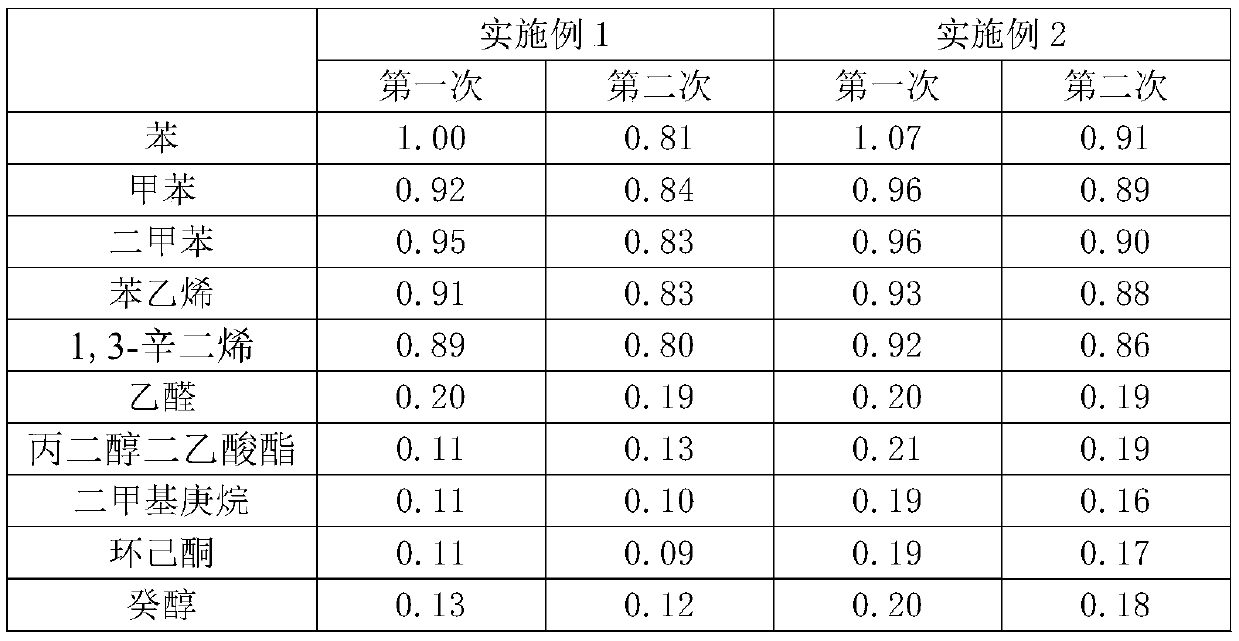Method for detecting odor substances of whole automobile
An odor and substance technology, applied in the field of automobile volatile odor detection, can solve the problems of insufficient detection strength, heavy odor, non-existence, etc., and achieve the effect of avoiding omissions
- Summary
- Abstract
- Description
- Claims
- Application Information
AI Technical Summary
Problems solved by technology
Method used
Image
Examples
preparation example Construction
[0043] Described hyperbranched polyurethane preparation method comprises the steps:
[0044] (1) In the container, add 0.05mol of 3-amino-N-(2-mercaptoethyl) propionamide and 0.1mol of hydroxyethylethylenediamine under the condition of feeding nitrogen, and stir under an ice-water bath;
[0045] (2) Add dropwise a methanol solution of 0.075mol 2,3-epoxypropyl acrylate and 0.075mol methyl acrylate to the system of the first step, and stir at room temperature for 2 to 4 hours, then evaporate and concentrate to obtain intermediate body;
[0046] (3) Add 0.25 g of p-toluenesulfonic acid to the intermediate in the second step, and the system is heated up to 120° C., reacted under stirring for 3.5 hours, evaporated and concentrated to obtain the hyperbranched polyurethane.
[0047] In some embodiments, the weight ratio of the cyclodextrin to the hyperbranched polyurethane is (0.6-1.2):1.
[0048] In the present invention, due to the difference between the interaction force between...
Embodiment 1
[0071] Example 1 Provided is a method for detecting odorous substances in a vehicle, comprising the steps of:
[0072] (1) The adsorbent is placed in a container containing vehicle odor substances to adsorb the odor substances;
[0073] (2) Put the adsorbent adsorbed with the odor substance in the headspace bottle, desorb the odor substance therein, and pass the odor substance into the GC-O / MS;
[0074] (3) GC-O / MS separation and qualitative and quantitative detection of components and contents of vehicle odor substances;
[0075] The adsorbent is a porous organosilicon material prepared by using a mixture of cyclodextrin and hyperbranched polyurethane as a template and polyorganosiloxane as a raw material through a sol-gel method.
[0076] Among them, the GC-O / MS separation and qualitative and quantitative detection process includes the following steps:
[0077] 1. Add the odorous substances in Table 1 into the headspace bottle, shake to mix, push the SPME handle to penetrat...
Embodiment 2
[0095] Example 2 Provided is a method for detecting odorous substances in a vehicle, comprising the steps of:
[0096] (1) The adsorbent is placed in a container containing vehicle odor substances to adsorb the odor substances;
[0097] (2) Put the adsorbent adsorbed with the odor substance in the headspace bottle, desorb the odor substance therein, and pass the odor substance into the GC-O / MS;
[0098] (3) GC-O / MS separation and qualitative and quantitative detection of components and contents of vehicle odor substances;
[0099] The difference from Example 1 is that the adsorbent is a porous organosilicon material prepared by a sol-gel method using a mixture of cyclodextrin, hyperbranched polyurethane and a cucurbit compound as a template, and polyorganosiloxane as a raw material.
[0100] The preparation method of described adsorbent comprises the steps:
[0101] (1) Blend 0.2 mol of tetramethoxysilane and 0.2 mol of organosilane containing styrene structure, and add 20...
PUM
| Property | Measurement | Unit |
|---|---|---|
| Viscosity | aaaaa | aaaaa |
Abstract
Description
Claims
Application Information
 Login to View More
Login to View More - R&D
- Intellectual Property
- Life Sciences
- Materials
- Tech Scout
- Unparalleled Data Quality
- Higher Quality Content
- 60% Fewer Hallucinations
Browse by: Latest US Patents, China's latest patents, Technical Efficacy Thesaurus, Application Domain, Technology Topic, Popular Technical Reports.
© 2025 PatSnap. All rights reserved.Legal|Privacy policy|Modern Slavery Act Transparency Statement|Sitemap|About US| Contact US: help@patsnap.com



